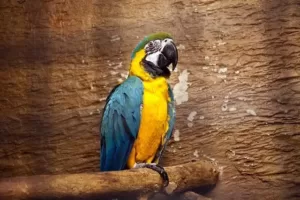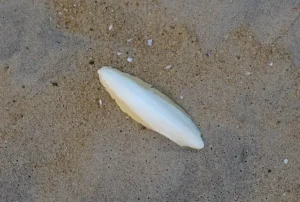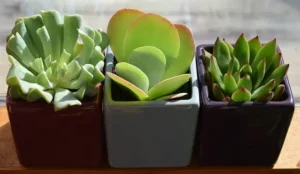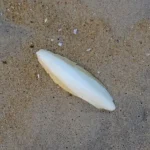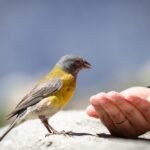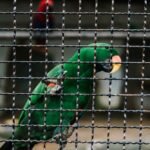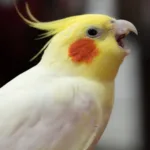The ideal length for parrot nails can vary, but generally, it should be the length at which they can perch comfortably and securely grip objects.
If your parrot’s nails are too long it will have trouble performing simple daily tasks like holding food with its foot, climbing on cage bars, and even perching and walking.
But of course, you shouldn’t wait for the nails to grow to a point where they become a problem for your parrot.
You should trim your parrot’s nails at regular intervals and monitor their growth so you know exactly how often they need to be trimmed.
Quick Navigation
6 Signs Of Overgrown Parrot Nails
Besides a visibly long nail, there are other signs you can look for that can help you determine whether your parrot needs a nail trim. Below are the common signs your parrot’s nails are too long:
Difficult In Perching
When your parrot’s nails become excessively long, it can make it extremely difficult for them to perch properly. They may be able to stand on a flat surface, but it can be harder to get a secure grip around a circular perch.
You may also see that they have trouble maintaining balance and occasionally stumble on the perch. Parrots may also accidentally slip and fall off their perch because of the grip issue.
Also, if your parrot’s nails get overly long on both sides, it may appear to limp or walk awkwardly. This happens because the parrot cannot bend or lift its feet, which makes them being dragged along.
Curled Nails
Curled nails mean that you have let your parrot’s nails grow far too long. Parrots have two toes pointing front and two toes at the back. When your parrot’s nails grow too long, they curve inward on each other.
In this situation, it will be very difficult for your parrot to perch or even walk. Ideally, you should cut your parrot’s nails way before they get curled like this.
Biting Own Nails
If you see your parrot biting its own nails, it could be another sign that it needs a nail trim. In the wild, parrots are able to maintain their nails through activities like chewing, climbing, and perching on rough branches. If your parrot does not have a perch that can help them in filing, they may start biting their nails.
Sharp Nails
A parrot’s nails can get sharp without necessarily being too long. If your parrot’s nails feel too sharp to touch or if they scratch your arms while being perched on it, it means they are not filed properly.
This can be due to a lack of variety in perches or providing them with a soft perch like birch dowel.
Cuts On Feathers And Skin
Sharp nails aren’t just unsafe for you, they can be harmful to your bird as well. Parrots sometimes scratch their feathers using their claws when they’re itchy. If the nails are too sharp, they can hurt your parrot and leave cuts on the skin and the feathers.
Flaky Nails
Parrot nails are made of keratin, which is the same material that our fingernails are composed of. Unkempt claws often get flaky as they continually grow layers of keratin.
How Often Should You Clip Your Parrot’s Nails?
The rate at which your parrot’s nails grow depends on many factors such as their size, diet, and most importantly, the variety of perches they have. In the wild, parrots do not have to worry about nail overgrowth.
Wild parrots maintain their nails by scratching their nails on rough surfaces, such as tree branches, which helps naturally wear down their nails.
However, in captivity, their nails can grow at a faster rate. Some smaller parrots need their nails trimmed every 2-3 months, whereas the larger parrots need a trim every 6 months.
If you let your parrot’s nails grow too long, the quick will grow as well, making it difficult to cut the nail short.
Conversely, if you trim your parrot’s nails at regular intervals, it will cause the quick to recede and make it easier to trim the nails the correct length.
So, whether you clip your parrot’s nails yourself or take them to a vet, make sure you’re doing it regularly and not letting the nails grow too long. It’ll also make your parrot less scared of the experience.
How To Maintain Your Parrot’s Nails?
Parrots can maintain their nail length naturally when they get sufficient exercise and opportunities to scratch their nails. You should provide your parrot with different perch types that will help keep their nails short.
Natural wood branches are often the best for your parrot’s feet. Parrots can use them to file their nails as well as their beaks.
You should avoid sandpaper perches as they are abrasive to the parrot’s feet and can cause sores. Some birds may even choose to eat sandpaper cover.
However, you should still have other soft perches like rope perches for your parrot because standing on rough surfaces for too long is not particularly good for them.
According to Heidi L. Hoefer, DVM, DABVP (Avian), rough perches should be used cautiously as perching on hard surfaces for extended periods can potentially lead to pododermatitis.
How To Trim Your Parrot’s Nails
Trimming your parrot’s nails is not an easy job and requires some level of experience in order to do it correctly. It is not ideal if you’re doing it for the first time all by yourself. For your parrot’s first trim, I suggest you take it to a professional and watch them do it once in person.
Having seen it being done can prepare you for how your parrot reacts and how you should respond to them. A big part of trimming your parrot’s nails involves making them feel secure.
Parrots don’t like being restrained and can quickly become uneasy. So before you do this, make sure your parrot is calm and trusts you fully. Now let’s get to the steps on how to clip your parrot’s nails:
What You’ll Need
These are the things that you will need:
- A towel to hold your parrot.
- Styptic powder or cornstarch – In case you cut the nail too short and your parrot starts bleeding. Keep the powder ready in a bowl.
- Nail Clippers – Use bird nail clippers only. A regular nail cutter is not suitable for cutting your parrot’s curved nails.
- A person to hold your parrot.
Desensitize The Parrot To The Clippers
Most parrots are fearful of new objects, and if this is the case with your bird, you should first introduce them to the things you’re going to be using. Show your parrot the nail clippers you’ve got and see if they are not scared of it.
If your parrot seems okay with the clippers, bring them near and let it touch it with its beak. When it touches the clippers, reward it with a treat. This will make the parrot less scared of the clippers once you begin clipping its nails.
Towel Wrap Your Parrot
The nail clipping procedure can be all too overwhelming for your parrot. Wrapping your parrot in a towel makes them feel a sense of calm and does not make them feel like they are being restrained by force.
Use a towel that is the appropriate size for your bird. If the towel is a little bigger, you can fold it to make sure it comes nicely underneath your bird. Now, you do not have to wrap the towel around your parrot.
Instead, you need to place the towel under your parrot and hold them gently, keeping your index finger over their head. You can also cover your parrot’s head to keep them relaxed.
Determine Where To Clip
While cutting your parrot’s nails, you need to be careful of the quick. The quick is the part of a parrot’s nail that contains blood vessels and nerves.
It can be seen more easily in parrots with light-colored toenails. You can see where the quick is by holding your parrot’s feet to the light.
It will appear as a pink colored strip that runs through your parrot’s nail. It is crucial to avoid cutting into the quick as it can cause bleeding.
However, in parrots with dark-colored nails, you cannot see the quick. So in order to determine the length at which you should cut their nail, you need to figure out how much of your parrot’s nail length is in excess.
One way to do this is to look at your parrot’s feet on a flat surface. Normally, your parrot’s feet should be flat against the surface. But if the nails are too long, it can make the feet curl.
Imagine a straight line starting from the tip of your parrot’s feet and you’ll be able to see the part that is extra. However, since you cannot actually see the quick, it is best to cut only a small part from the front and file the rest of the nail.
Be Prepared For Jerky Movements
As the other person is holding the bird, carefully position your parrot’s nails between the clippers. Once you have your parrot’s nail between the clippers, gently squeeze to perform the clipping action, but don’t clip yet. First, you need to see how your parrot reacts to the clipping action.
You should not immediately get into clipping your parrot’s nails because they can fidget and jerk during this process.
This is the most common reason why people accidentally cut the quick. If your parrot clenches its feet just as you’re about to clip its nails, try to first calm your parrot down and only cut when it is ready.
Clip The Nail
When you feel confident enough and your parrot is not refraining from getting its nails clipped, you can clip its nails.
Make sure not to clip too much. It is always better to clip less than clipping too much which can make your parrot bleed.
Also don’t forget to reward your parrot for the good behavior. Reward your parrot after the nail clipping is done so that it associates it with a positive experience.
What To Do If Your Parrot’s Nail Starts Bleeding?
If you accidentally cut your parrot’s nail too short, you may cut into the quick and it can start bleeding. This can be a very serious situation especially if your parrot is small. Even a few drops of blood can be life-threatening for a smaller parrot species.
However, you should not panic. Grab the bowl of styptic powder you had prepared and dip your parrot’s feet in it. The styptic powder coagulates the blood and stops the bleeding.
